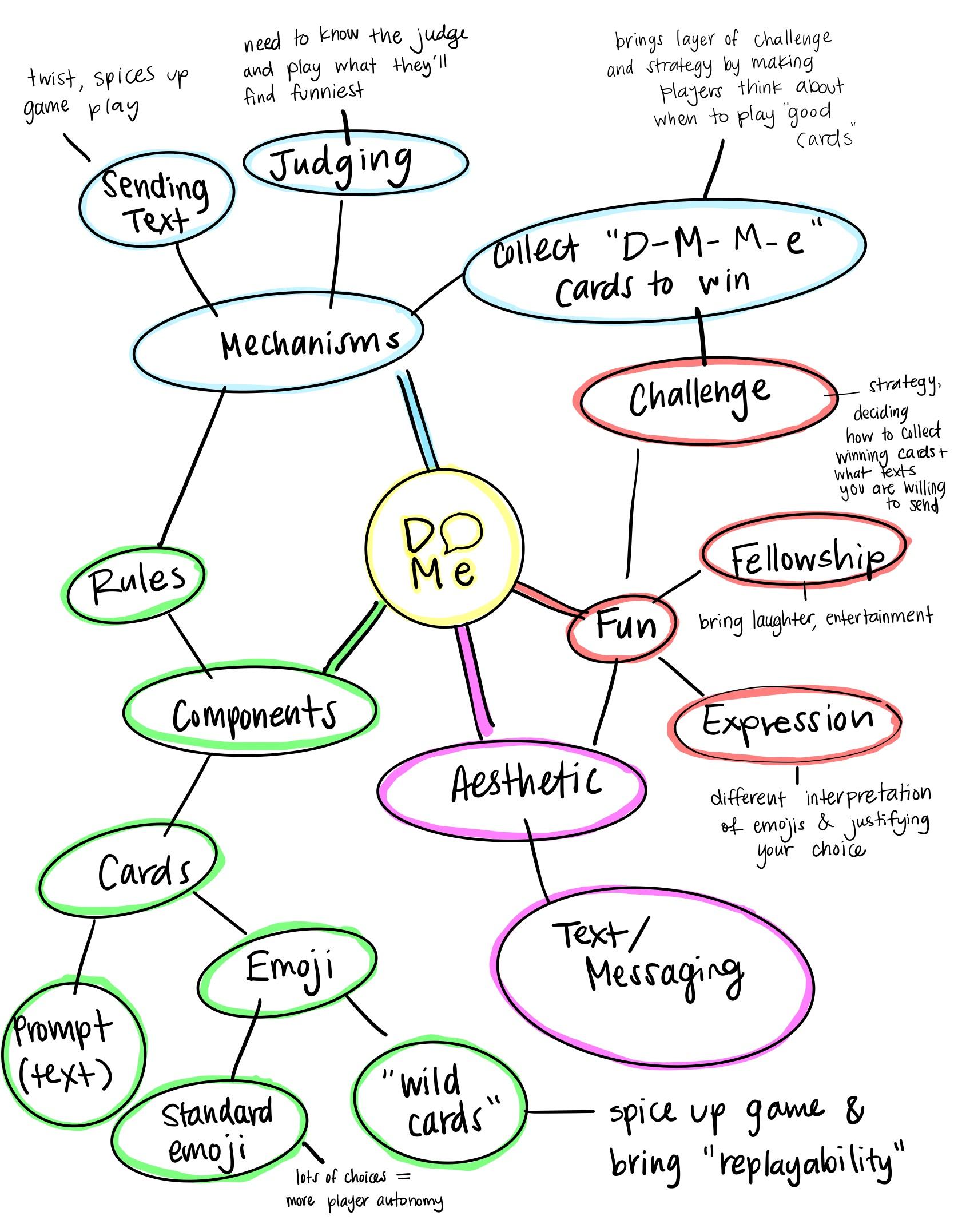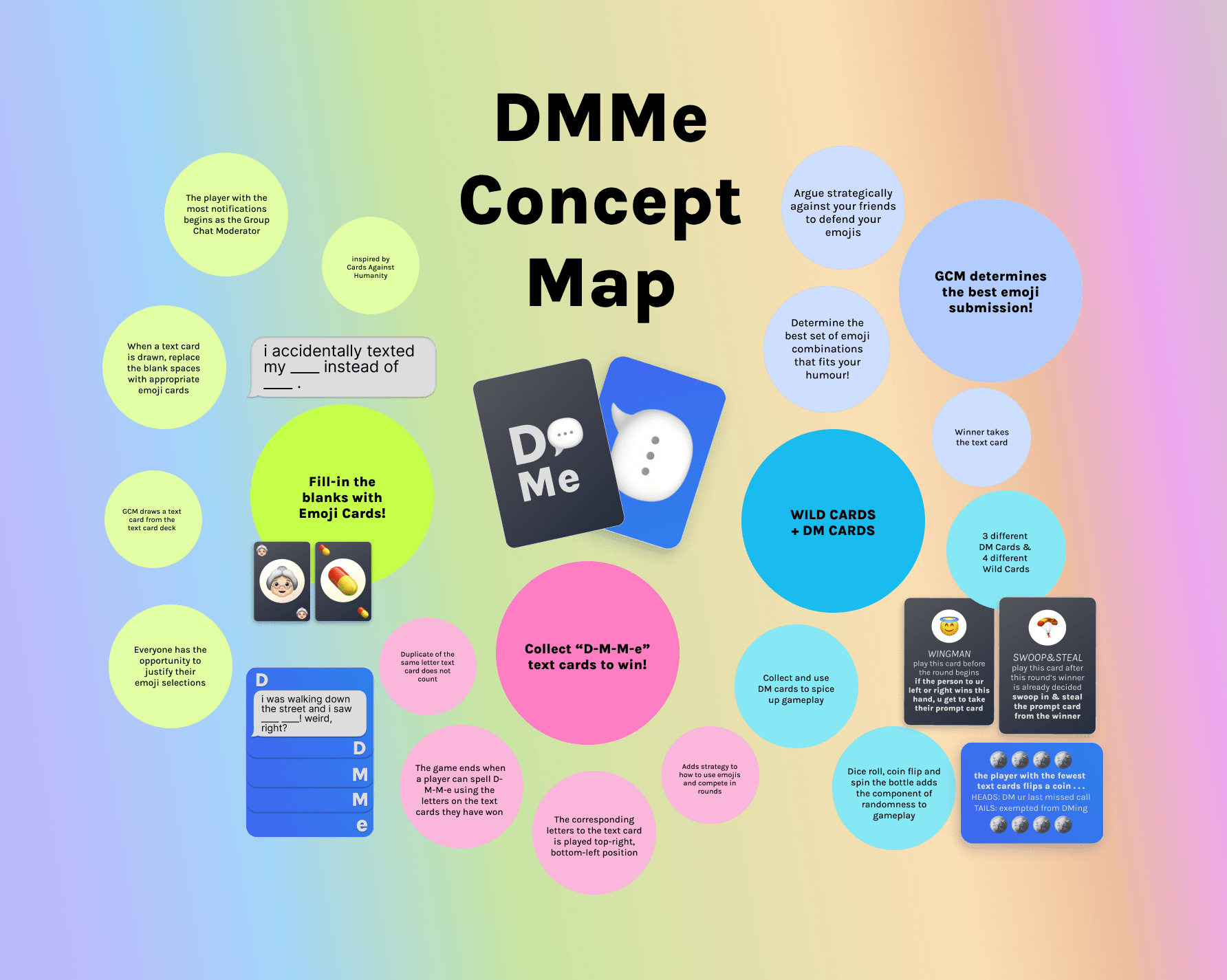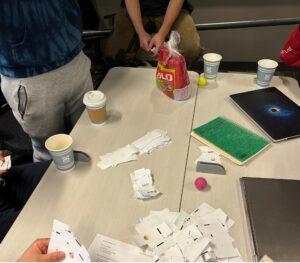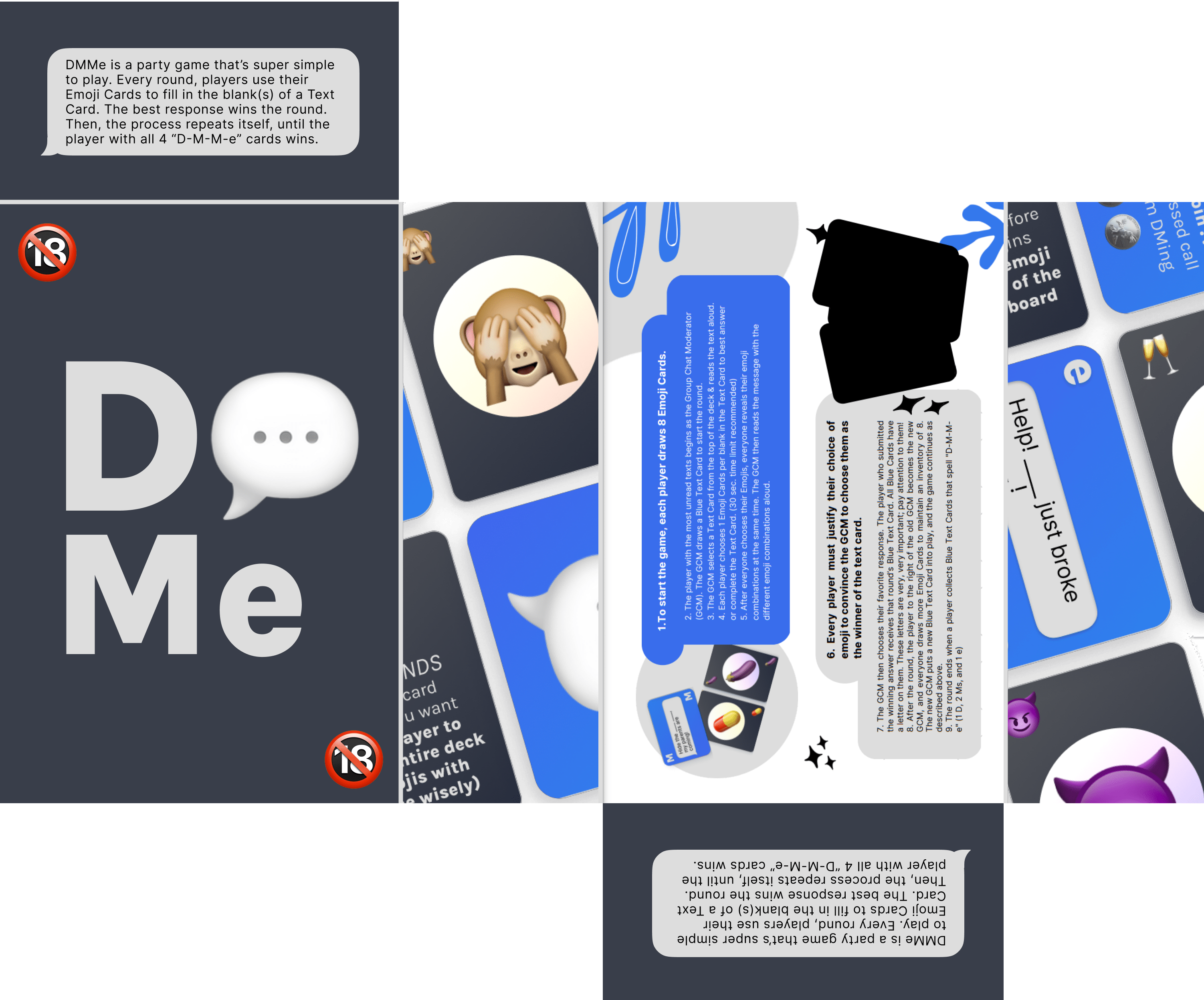ARTIST’S STATEMENT
DMMe is a fill-in-the-blank party game that turns your awkward personality and lackluster social skills into hours of fun!
It’s super simple to play. Every round, players use their Emoji Cards to fill in the blank(s) of a Text Card. The best response wins the round. Then, the process repeats itself, until the first player to spell “D-M-M-e” using the letters on the Text Cards they have is the winner.
DMMe is an exploration of the ways in which we use emojis to categorize and make sense of our experiences. At its core, DMMe is a game that challenges players to create connections between seemingly disparate concepts/emojis. Each player is given a hand of cards, each of which contains a different emoji. One player then draws a card from a central pile, which contains a single text, and the other players must select 1-3 card(s) from their hand that they feel best fills in the blanks. The player who selected the most fitting card(s) wins the round. But beyond its function as a game, DMMe is a meditation on the power of emojis to shape our understanding of the world. By forcing players to draw connections between seemingly unrelated concepts, the game invites us to rethink the way in which we categorize and understand the world around us. In a society that often seeks to divide us along narrow lines, DMMe is a reminder of the interconnectedness of all things, and the power of emojis to unite us in unexpected ways.
IDEATION EXPLORATION → CONCEPT MAP


INITIAL DECISIONS
From the outset, our primary focus was to emulate the framework of Cards Against Humanity (CAH). We appreciated the game’s simplicity and recognized the potential for expansion. Unlike CAH, which primarily relies on dark humor, we aimed to introduce new themes and mechanics to the game to explore new dynamics. We first examined various adaptations of CAH, by playing Trumped Up Cards and What Do You Meme?, which revolved around similar mechanics and themes. Then, we identified key fundamentals of the game that would set our game apart.
As aforementioned, our inspiration came from Trumped Up Cards and What Do You Meme?, clever variations of Cards Against Humanity that introduced the concept of employing emojis as responses to prompts. While CAH uses text-based prompts that may limit creativity and expression, What Do You Meme? leverages well-known meme images, providing players with greater autonomy in their arguments. Upon playtesting What Do You Meme?, a team member observed that utilizing memes allows for “a broader range of responses” and “multiple interpretations,” making the game more engaging. Consequently, we incorporated emojis as a means of communication, offering players the ability to express themselves through various emoji combinations.
After selecting emojis as a core game component, designing prompt cards within an iMessage/text context was a natural progression. Our initial prompt card iteration encompassed a broad spectrum of political correctness, from explicit sexual references to more subdued themes. Following extensive playtesting, we discovered that players enjoyed the game most when prompts accommodated both milder and slightly sexual/inappropriate interpretations.
To distinguish our game from the original, we investigated several mechanics that would seamlessly integrate with our game flow. We were familiar with the singular judging system of CAH, where one player evaluates the responses of others. To enhance this aspect, we considered various ways to refine the judging process while maintaining the game’s core engagement and enjoyment factors.
DMMe’s Finalized Formal Elements:
- Players: The game can be played with three or more players. Players can be of any age, but the game is recommended for players aged 18 and above due to mature themes and content.
- Objectives & outcome: The objective of the game is to create the funniest, most outrageous, or most inappropriate answer to a given question or statement. The outcome of the game is that the first player to spell D-M-M-e using the letters on the Text Cards they have is the winner.
- Procedures & Rules: At the beginning of each round, one player is designated as the Group Chat Moderator. The GCM draws a Blue Text Card, which contains an iMessage with one or more blanks to be filled in. The other players each play one or more Black Cards from their hand, which contain emojis that complete the text on the Blue Card. The GCM selects the funniest or most appropriate answer and awards the Blue Text Card to the player who played those cards. Play continues with the next player becoming the GCM for the next round. The game can be played until a player can spell D-M-M-e using the letters on the Text Cards they have won.
- Resources: Blue Text Cards & DM Cards; Black Emoji Cards & Wild Cards.
- Boundaries: The game is intended to be played in a casual, social setting. While the game contains mature themes and content, players should still be respectful of each other.
Furthermore, DMMe primarily offers two distinct types of enjoyment: expressive aesthetics and sensational aesthetics. Expressive aesthetics are emphasized through the game mechanics, which allow players to choose combinations of two emojis to convey meaning. The multiple interpretations of emojis enable a broader scope of expression than games such as “Cards Against Humanity.” Sensational aesthetics are showcased through the risqué content found in the text and emoji cards. During our initial playtesting, we discovered that the text cards eliciting the strongest reactions were those that could be perceived as both inappropriate and innocent. Additionally, the presence of visual emojis symbolizing sexual themes further contributes to the sensational aspect of the game.
TESTING & ITERATION HISTORY
We tested 3 of 5 different iterations of our prototype with our main target audience: young adults. Our target audience was 18+ because of the politically incorrect emojis/words that would be deemed inappropriate for underaged children; we also targeted young adults as they would be able to find the use of emojis in the response to prompts in the form of texts natural. Each playtest included a moderator/a member of our team to explain the game & a notetaker to observe and record the behaviors of the playtesters. We have also summarized a brief & more visual overview of our findings from different iterations of the game for your viewing convenience!
First Iteration: JUDGING
Playtested by Team 7, playtested 3 rounds
To playtest our first iteration, we created a low-fidelity paper version where we printed the text messages with blanks along with a small assortment of emojis. The game operated using a judging mechanism where a winner was declared each round and the goal of the game was to collect the highest number of text cards.
What went well:
- We observed a lot of laughter and banter as players shared their emoji choices with the group to and to the judge. It seemed like they were having fun and enjoying the interpretability of the emojis as well as their individual creativity.
- timestamp 1:47 – the judge reads the message with the emojis out loud and dies of laughter
- It was helpful when the judge of the round read the text card out loud as it was more engaging and inspired some amount of dialogue. We decided to encode this in our rules.
What didn’t:
- The text size on the text cards was way too small which made it difficult for players to read the text they were trying to complete. We decided to size up our font so as to make it more accessible for everyone and less work to read.
- Text cards that had 3 blanks were too confusing for players. We decided to only have 1 – 2 blanks in our text cards to simplify it.
- timestamp 0:20 – player says “What?” and proceeds to grab the text card to look at it since it wasn’t easily understandable from just hearing it
- Players felt like there weren’t enough emojis. They wanted a greater variety of emojis and more autonomy during game play, which as we learned in class, is a very important aspect of gameplay that keeps players coming back.
Second Iteration: 2.0, 2.1 & 2.2; JUDGING w/ “DMe” COLLECTION
Playtested by Alex, Dylan, Jiwon, & Kaitlin 3 times
To playtest our second iteration, we used the same low-fidelity paper version from the first round, but we wrote in the D, M, and e on the text cards to test the new win condition. We also implemented the Group Chat Manager (GCM) as the judge this time around, and added mechanic of choosing the GCM based on who has the number of phone notifications.

What went well:
- Again, we observed laughter and fun during judging. Players also seemed to have fun while looking through their cards and deciding what to play. There was a lot of banter and joke making after each person laid down their emojis which contributed to fellowship amongst the players.
- The players also commented that they enjoyed using emojis since they can be interpreted differently which facilitates the fun of expression.
- The introduction of the new mechanic of making players collect the 3 “D-M-e” cards worked well. This rule led to an element of strategy being introduced as players had to optimize their play to collect each of the cards instead of attempting to get every single card.
What didn’t:
- Players had to sift through their cards each time they needed to play and could only see one emoji in their hand at a time. In card games, it is important to allow players to assess the content of their hands easily.
- We noticed that people didn’t actually end up justifying their answers most of the time which took away from some of the dialogue being exchanged and the personal expression of each player that could be demonstrated while trying to convince the judge of why they should win the round.
Major changes:
- We added “D-M-e” to the text cards and the new rule that ends the game once a player has collected all 3 of these cards. The added layer of strategy gave the game greater complexity and introduced some new fun through challenge.
- We got rid of all text cards that had more than 3 blanks to respond to feedback given that it was too complex.
Third Iteration: 3.0 & 3.1; CROWDSOURCED JUDGING + WILD CARDS
Playtested by Jake, Valeria, Sasha, & one other for 5 rounds
For this playtest, we used a higher-fidelity paper prototype and introduced new mechanics, namely crowdsourced judging, as opposed to a singular judge per round, and wild cards. Every round, all players play an emoji combination as well as vote. We allowed for self-voting and awarded the text card to the player with the highest positive score. We later removed the “dislike react” after seeing it was confusing during round 1 of the play. Lastly, we added in four wild cards (detailed below) that were used to add new game mechanics and increase the “replayability” of the game by spicing up the rules.
PLAYTEST #2 | our OG print & play | PLAYTEST #3
What went well:
- Again, players seemed to like the added mechanic of collecting “D-M-M-e” cards that led to strategizing which players said they liked.
- We changed the layout of the emoji cards to include one main emoji in the center and two small emojis, one in the top, left corner and one one in the bottom, right corner. Players really appreciated being able to easily see all of their emoji cards at once instead of having to sift through them one by one each time they need to play.
- Even with the two small emojis added to the deck, there wasn’t enough contrast between the black card background and the emoji for some emojis, and this was something that we wanted to fix
- We added various wild cards into the emoji deck that resulted in new dynamics being introduced.
- Emoji Deck
- Choose any face emoji
- Used like any other emoji card, but the player gets to choose which face emoji they want to use
- Choose any drink emoji
- Used like any other emoji card, but the player gets to choose which drink emoji they want to use
- Choose any monkey emoji
- Used like any other emoji card, but the player gets to choose which monkey emoji they want to use
- Choose any bird emoji
- Used like any other emoji card, but the player gets to choose which bird emoji they want to use
- Choose any fruit emoji
- Used like any other emoji card, but the player gets to choose which fruit emoji they want to use
- Timestamp 0:50 in Playtest 2.0 – player played this card and chose the banana emoji
- Switch Emoji
- Played before the round begins
- Exchange an emoji card with any of the ones on the board
- Choose any face emoji
- Text Deck
- Wingman
- Played before the round begins
- If the person to the players left or right wins this hand, they get to take that text card
- Swap Hands
- Play this card at any time
- Pick a player to swap emoji decks with
- Steal
- Play this card after the round’s winner is already decided
- Swoop in & steal the text card from the winner
- Wingman
- Emoji Deck
What didn’t:
- We introduced a “like react” and a “dislike” react in this iteration
- Timestamp 0:50 – 1:00 in Playtest 2.1 – Players were discussing the voting mechanic which was introduced for the first time
- Group voting as opposed to individual voting – voting for yourself didn’t work well. Additionally, voting is a “silent thing” so it squashed the laughter and banter amongst players.
- Players didn’t appreciate not having a time limit as some of the players got bored waiting for the stragglers to pick their finalized emoji cards.
- Having the change of mechanism cards in the text deck didn’t work well, so we decided to move the four wild cards to the emoji deck to improve game flow.
Major changes:
- Adding the “like react” and “dislike react” allowed for group voting which was not enjoyed by the players.
- Group voting instead of having a single judge seemed to create a much quieter round with less banter back and forth and laughing. This compromised the fun of fellowship and seemed less enjoyable overall.
Penultimate Print & Play, Fourth Iteration: PIVOT…
After receiving feedback about our visual design, we decided to spend some time exploring a very different look and dedicated our fourth iteration to a new visual aesthetic.
We explored the use of different fonts and color schemes. The text cards were made a lighter, warmer blue while the emoji cards were made yellow and included a squiggly shape to back each of the emojis.


We tried out the new aesthetic but realized that it didn’t fit the theme that we were trying to convey. Our theme is a young, vibrant, sexy feel that is based off of iMessage and the idea of being a young adult living an exciting life in NY or some other big city. The new iteration of design wasn’t able to convey this feeling, but we did want to make the accessibility issues of text size and clarity of card type (between D, M, and e) better.
FINAL PROTOTYPE
Fifth Iteration: JUDGING + WILD CARDS
We finally arrived at our final prototype design which is a combination of the many insights we gained over the course of testing various iterations as well as a few final changes.
Ultimately, after trying a new visual motif, we chose to revert back to our original design with some small changes. For accessibility purposes, we made sure to make the text much larger than previous iterations. We also moved the D, M, and e demarcations to be in both the top corner and bottom corner of the cards and made them larger so as to make them much easier to see. The emoji cards were also updated to include a circular backing behind each emoji that was designed to provide contrast and make the emoji visible instead of being directly on the black background. We decided to commit to the text aesthetic for the reasons detailed above.
DMMe distinguishes itself from Cards Against Humanity in many ways. In addition to a completely different visual aesthetic and theme, DMMe’s gameplay is spiced up with a variety of mechanic changing wild cards as well as game repercussions that expand beyond the game (i.e. sending our real DMs of texts created during the game). The premise built upon emojis also lends itself to the fun of expression as emojis are interpretable. Every emoji combination means something different to each player and thus, in combination with the wild cards, creates an unique gameplay experience each time.
Through the use of a sleek, sexy, modern aesthetic encompassing the vast variety of meanings derived via emojis, DMMe brings people together, both close friends and strangers, to create hilarious, out-of-pocket, and suggestive texts that are sure to make every laugh.
Major changes (since prototype 4)
- Reverted to original text design aesthetic
- Added the color-coordinated circle on the emoji cards as emoji backgrounds to make them more accessible
- Text cards
- Requiring collection of “D”, “M”, “M”, “e” cards instead of just “D”, “M”, “e”
- Makes the game slightly harder
- Put these letters in both the top and bottom corner of the text cards to make them more cohesive with the emoji cards
- Increased the size of the D, M, e for accessibility’s sake
- Added three variations of a new wild card in the text deck involving players having to send a real DM to someone in their contacts list
- Added drop shadows to bubbles and letters to match the emoji shadows and make it pop
- Requiring collection of “D”, “M”, “M”, “e” cards instead of just “D”, “M”, “e”
- Emoji cards
- Made sure to include small emojis in the corners so that players can see what cards they have in their hands without shuffling through them
- Added circle around the center emoji to create better contrast for accessibility and overall look
- Personalized the color of the circle to match the emoji color
- Like card
- Not used for voting
- Used to track who the current group chat manager is and what their choice is
- Rules
- Explain all wild cards and how to play / how they change game dynamics in the rule book
- We formally encoded the need to “justify your answer” in the rules to encourage greater dialogue and engagement
- We suggested a 30 second limit to lay down emoji cards
- Wild cards allow for replayability and keeping DMMe fun and exciting
- Aesthetic (kind of fun)
- Fellowship
- Players have to learn each judge’s preference and try to please them with their emoji choices
- Laughter at emoji choice
- Justification of emojis played and storytelling
- Expression
- How texts and emojis are interpreted
- Fellowship
—
MARKETING!




